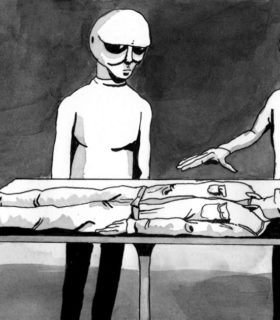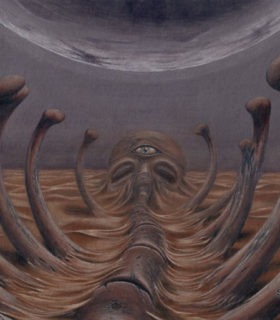My friend Chaim Mendel shared a disarmingly good question about the relationship between desire and transgression which has been nagging me a lot recently:
Why is the forbidden so erotic? What is it about transgression that is so central to the nature of desire?
Transgression or perversion isn’t only an erotic category. It’s a very broad field which can include aesthetic and intellectual practices as well as carnal ones. Thus, for example, I’ve argued that posthumanism in all its forms is an inherently perverse (transgressive) operation because it disables the, broadly humanist, frameworks that support ethical deliberation. It isn’t ethical but (to pervert Claire Colebrook’s term) ‘counter-ethical’. It subtracts the constraints that normally apply when we’re deliberating about politics or the future of life, leaving only fragile, theoretically unstable ontological schemas such as materialist vitalism in its wake (see here and Roden Forthcoming).
However, here I want to focus on carnal practices, allowing that there may be analogies with or possible extensions to theoretical transgression. My response to Chaim was partly inspired by Leo Bersani’s wonderful 1986 book The Freudian Body. Here, Bersani argues that Freud’s homeostatic theory of pleasure – which treats it as a discharge reducing excitation to an optimal level for the organism – is troubled by erotic phenomena where, as in foreplay, pleasure is characterised by a “painful” increase of excitation.
And this, of course, doesn’t engage with the erotics of masochism or sadism, where pain in various forms becomes the currency of desire. So pleasure, it seems, is already marked by a lack of economy; an excess which cannot correspond to the Epicurean ordinance towards moderation and health. Sexual pleasure involves a jouissance that is both shattering and pleasurable. For Bersani, this implies a wholly other economy of pleasure that is no longer governed by the constancy principle, but by the masochistic desire for an experience of psychic dissociation or ‘shattering’.
We must assume that there is an excessive pleasure involved in psychic shattering or loss of self. This is pleasure that is literally too much and would thus (in Lacanian terms) correspond to an excess or jouissance that cannot be accommodated in the symbolic order. Eroticism or sexuality thus maps onto this troubling pleasure. Hence my initial answer to Chaim:
In transgression we lose the normative moorings that define the body and its possibilities under normal condition, including those of the sexualised body, and experience it as something fluid, open, even inhuman.
Experiencing the body as inhuman is not the same as becoming inhuman or seeing oneself as a particular kind of nonhuman – e.g. a machine or animal – although both notional forms of nonhumanity might be involved in this experience. It’s an experience of outsideness, of ecstasy that may also involve estrangement from the normal categories under which the we self-conceive or self-describe the body.
However, this gives me to wonder how we might unpack my this schematic reply in terms of psychological, cognitive or neuroscientific models. We could start with a concept of the ‘imago’ used in Lacan. Catherine Waldby distinguishes this from the more familiar idea of the body image, which is more of an online representation of the body’s current state (Waldby, 1995. 271, Butler 2011, 43-44).
The imago is more like an imaginary anatomy based, partly, on our social expectations of bodies, expectations which might be heavily gendered. Thus, expectations of masculine ‘invulnerability’ may contrast with gendered assumptions about the relative penetrability or accessibility of female bodies. To use Waldby’s example, if there is a taboo about penetrating the male body (e.g. in anal intercourse) we might expect a correlative form of erotic intensity or pleasure to accompany fantasies and practices involving anal penetration, one that involves the disruption (shattering) of the male imago which represents the male body as the penetrator/destroyer, etc.
In a sense then, anal eroticism is the sexual pleasure which conformation to a phallic imago most profoundly opposes. If the point of the phallic imago is to guard against confusion between the imaginary anatomies of masculine and feminine, and to shore up masculine power, then anal eroticism threatens to explode this ideological body. And if the rigid boundaries and penetrative intent of the phallic imago anatomize the non-reciprocity of subjective violence between men and women, then anal erotics in the male body amount to a surrender to the other, to a taking of pleasure in being destroyed rather than being the destroyer. But thenegative injunction of the phallus against such pleasure is, like all laws, also an invitation to transgression, and it seems likely that this phallic taboo might intensify, rather than disperse, the erotic potential of the anus for heterosexual men (Waldby 1995, 272)
So here the very invulnerability of the idealized male body incites transgression because of the excessive pleasure involved in breaching those imaginary boundaries. Anecdotally, I remember getting a lot of erotic pleasure from seeing Jarman’s Sebastiane (1976) precisely because of the way a gay male director seemed able to represent male bodies as soft, porous, inviting penetration (literally, in the denouement). This pleasure was both surprising to me (as, at the time, a young, nominally heterosexual male) but intense and affirming.
So, in Lacanian terms, Jarman’s movie deconstructed my heteronormative imago, letting in new imaginative erotic possibilities.
Ok, but does this this all ‘work’? Here, I’m going to be hyper-speculative, but here goes. Predictive processing models of the mind/brain suggest that action and thus our sense of a coherent self/agent depend on attenuating incoming flurries of current sensory information. Action on this account is a kind of explanation whereby high-level predictive models in the brain confirm their predictions by ensuring that the body gets into the situation they predict: e.g. grasping the desired cup.
This seems to require that the actual state of the body from current sensory data is downplayed. This might explain why attending to current action can ‘choke’ it, effectively weakening the predictive schema that organizes the action (See Clark 2015, 213-218). For example, if I learn a complicated be-bop lick on the piano but then overthink it while playing it, wondering whether to include a diminished 9th or not at a particular point, then I’ll probably fluff it (Roden 2019, 521). The incapacity for sensory attenuation of this kind is a pathology that has been associated with schizophrenia and autism (Clark 2015223-226).
So, where might transgression enter here?
Well, perhaps when we transgress, we may disable the high-level schemas that organize action and predict the possibilities of action or causes sensory stimulation. Perhaps social norms are embodied as hyperpriors: high-level predictions about how we will behave and feel. So, to take another example of relatively transgressive behaviour, sadomasochistic practices involving consensually inflicted pain (self or other inflicted) may disrupt our prior expectations which would normally discount the self or familiar others (partners) as sources of surprising tactile stimuli, increasing the informational significance that the cognitive system attributes to those stimuli, which we feel as increased intensity. The same effect may be derived from taboo situations (e.g. dating your boss, etc). In short, transgression may be a technology of auto-stimulation.
David Roden is a philosopher and writer interested in alternatives to being human. His book Posthuman Life: Philosophy at the Edge of the Human was published in 2014. His experimental prose work has been published in Gobbet, Dis Magazine, Surfaces, and Sunk Island Review. He blogs here.
References:
Butler, J., 2011. Bodies that matter: On the discursive limits of sex. Routledge.
Clark, Andy. 2015. Surfing Uncertainty: Prediction, Action, and the Embodied Mind. Oxford: Oxford University Press.
Colebrook, C. 2012a. “A Globe of One’s Own: In Praise of the Flat Earth.” Substance: A Review of Theory & Literary Criticism 41 (1): 30–39
Roden, D., 2019. Promethean and Posthuman Freedom: Brassier on Improvisation and Time. Performance Philosophy, 4(2), pp.510-527.
Roden, D. Forthcoming. ‘Posthumanism, Critical, Speculative, Biormorphic’, forthcoming in the Bloomsbury Handbook of Posthumanism, edited by Joseph Wamburg and Mads Rosendhal Thomsen.
Waldby, C., 1995. Boundary erotics and refigurations of the heterosexual male body. Sexy bodies: The strange carnalities of feminism, pp.266-77


